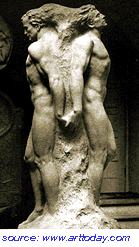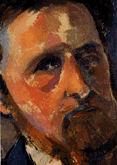Part Two in a Six-Part Series

by Alicia Potter
The new model of male perfection isn't John Wayne, or Burt Reynolds, but Marky Mark... as realistic an ideal for men as Cindy Crawford is for women.  On a busy Monday night the Boston Body health club, on Boylston Street, the after-five crowd files in to sweat off a weekend's worth of microbrews and pizza. In the weight-training area, a pack of guys grunt and heave like women in labor. On a busy Monday night the Boston Body health club, on Boylston Street, the after-five crowd files in to sweat off a weekend's worth of microbrews and pizza. In the weight-training area, a pack of guys grunt and heave like women in labor. Jay Knudson, 21, is one of them. The six-foot-four, 215-pound law student works out an hour and a half a day, five days a week. "Guys who are working out in their 20s are not doing it so much for their health," he says between biceps curls. "They're doing it for the look." What look are they shooting for? Currently, two competing body types dominate the pages of GQ and Men's Health. The first is a slender, sculpted, almost feminine look (think Brad Pitt); the second is a pumped-up but still low-fat physique (think Nicolas Cage). Both images differ greatly from past ideals of male perfection; not so long ago, the manliest men in popular culture were burly, barrel-chested, even hairy. Think of John Wayne in the '40s, Burt Lancaster in the '50s, Steve McQueen in the '60s, Burt Reynolds in the '70s — these guys probably couldn't even point out their deltoids, never mind sculpt them. But this indifference to their appearance only made them sexier. Then came the '80s, the decade of aerobics, jogging, tofu — and two ubiquitous advertising campaigns featuring male bodies. The Soloflex guy and the Calvin Klein underwear model represented a whole new breed of man. Their bodies, precursors to the Pitt and Cage looks, were hairless and lean, feminized and decidedly self-conscious. According to Daniel Harris's 1997 book The Rise and Fall of Gay Culture (Hyperion), this new body aesthetic had grown partly out of trends in the gay community. For decades, Harris writes, the most attractive gay men had cultivated a slender, more feminized appearance. With the dawn of AIDS in the '80s, however, gay men began to equate a slight physique with sickness, and they flocked to the gym. The perfectionist masculinity of gay gym culture quickly captivated Madison Avenue: think of Marky Mark, smirking in his Y-fronts across billboards and magazine pages. And although Marky himself was a celebrity, most of these ads divorced men's bodies from their personalities in a way that hadn't been done before. Who could name the Soloflex guy? The Diet Coke guy? High school girls could now line their lockers with magazine ads featuring anonymous male physiques as unrealistic as the swimsuit models their male classmates were drooling over. Meanwhile, men were eyeing those diamond-hard abdominals and thinking that maybe, with enough time in the gym, they too could get cut. The average guy, of course, can no more shape his torso into Marky Mark's than the average gal can whip herself into Cindy Crawford. But suddenly men were presented with a demanding ideal that seemed achievable through hard work. And that myth persists. Marcus Schenkenberg, the first man to enter the stratosphere of supermodeldom, has released a new, photo-cluttered biography in which he shares his workout routine with average Joes. His gut-conditioning tip: 650 abdominal crunches a day. This article originally appeared in The Boston Phoenix. Part Three: Body Obsession and Exercise Addiction |








